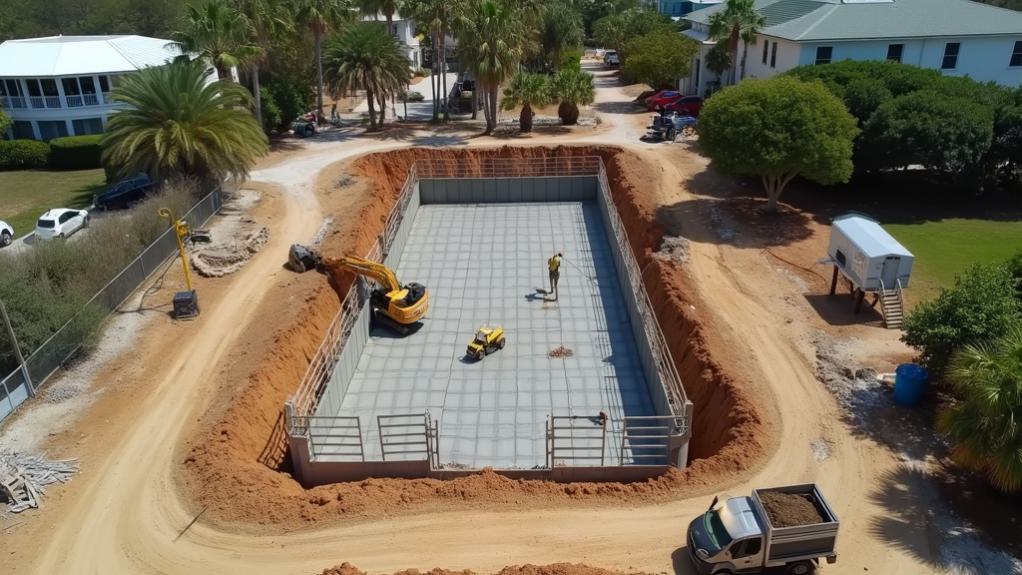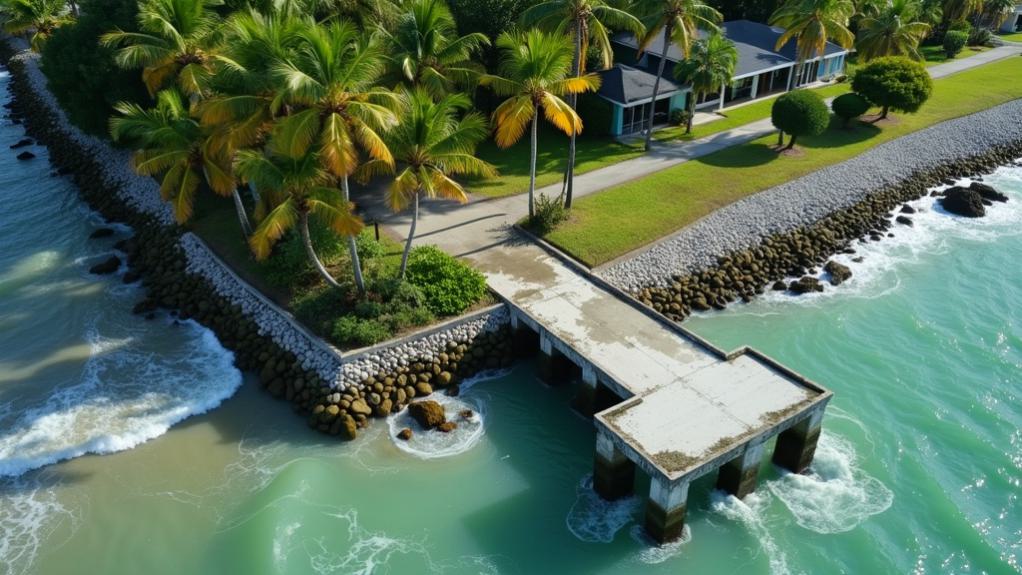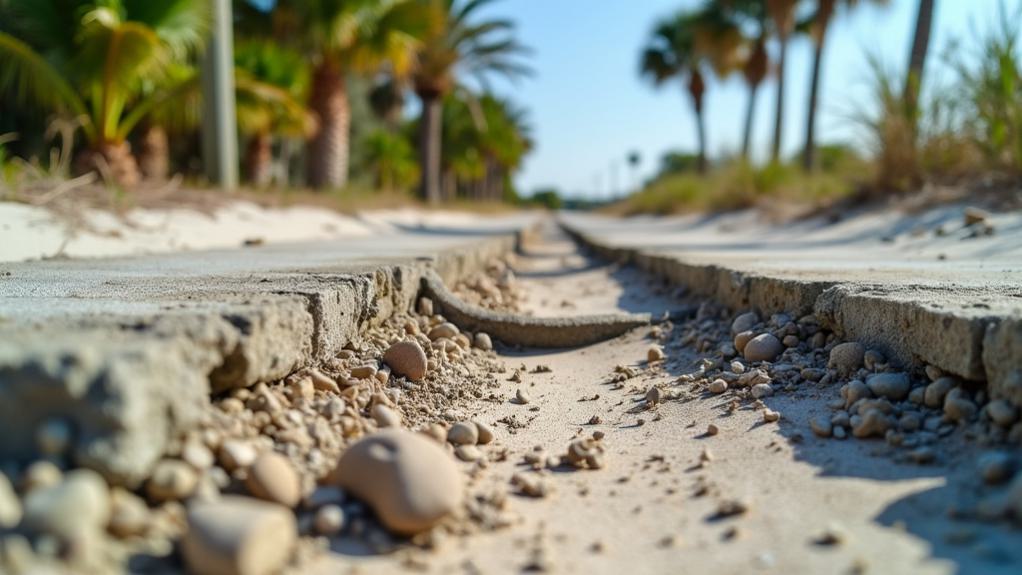Concrete foundations in Florida demand specialized construction techniques to address unique challenges. High water tables, sinkholes, and sandy soils necessitate robust site preparation and reinforcement methods. Slab foundations are common, with monolithic slabs integrating footings and slabs efficiently. Pier foundations offer stability in poor soil conditions. Concrete's durability against humidity and saltwater exposure makes it ideal for Florida's climate. Sinkhole mitigation involves techniques like compaction grouting and underpinning. Hurricane-resistant designs incorporate deep pilings and reinforced grade beams. Effective moisture control and waterproofing are crucial for longevity. Comprehensive maintenance strategies, including regular inspections and drainage systems, ensure the foundation's structural integrity in Florida's demanding environment.
Florida's Unique Construction Challenges

While many regions face construction challenges, Florida's unique geological and environmental conditions present distinctive obstacles for concrete foundation work. The state's high water table and propensity for sinkholes necessitate specialized soil stabilization methods to ensure structural integrity. Engineers must contend with loose, sandy soils that can shift unpredictably, requiring extensive site preparation and reinforcement techniques.
Florida's subtropical climate, characterized by high humidity and frequent heavy rainfall, poses additional challenges for concrete curing and long-term durability. Coastal areas face the added risk of saltwater intrusion, which can corrode reinforcing steel and compromise foundation strength.
Hurricane-prone regions demand enhanced structural designs to withstand extreme wind loads and potential storm surge.
Regulatory compliance adds another layer of complexity to Florida's foundation construction. Strict building codes, tailored to address the state's unique risks, mandate specific construction practices and materials.
These regulations often necessitate additional engineering assessments, such as geotechnical surveys and hydrological studies, to ensure foundations meet local requirements. Contractors must navigate these regulatory landscapes while implementing innovative solutions to overcome Florida's challenging geological and environmental conditions.
Types of Concrete Foundations
In response to Florida's unique construction challenges, engineers and builders employ various types of concrete foundations tailored to the state's specific conditions. The two primary categories of concrete foundations used in Florida are slab foundations and pier foundations, each designed to address particular soil and environmental factors.
Slab foundations, the most common type in Florida, consist of a single layer of concrete poured directly onto the ground. These foundations are further divided into three subtypes: monolithic slabs, stem wall slabs, and floating slabs. Monolithic slabs integrate the footing and slab into one pour, while stem wall slabs feature a raised perimeter. Floating slabs are designed to move slightly with soil shifts, making them suitable for areas with expansive soils.
Pier foundations, alternatively, utilize deep concrete columns to transfer the structure's load to more stable soil layers. This type includes drilled piers, driven piles, and auger-cast piles. Pier foundations are particularly effective in areas with poor surface soil conditions or high water tables, providing enhanced stability and flood resistance.
The choice between slab and pier foundations depends on factors such as soil composition, water table depth, and building design requirements.
Benefits of Concrete in Florida

Concrete foundations offer five key benefits for construction in Florida's challenging environment.
Firstly, they provide superior durability against the state's high humidity and saltwater exposure, which can corrode other materials.
Secondly, concrete's strength and stability make it resistant to hurricane-force winds and potential flooding, crucial for Florida's extreme weather conditions.
Thirdly, concrete foundations exhibit excellent thermal efficiency, helping to regulate indoor temperatures and reduce energy costs in Florida's hot climate. This thermal mass effect contributes to overall building sustainability.
Fourthly, concrete's versatility allows for various design options, accommodating Florida's diverse soil conditions and architectural styles.
Lastly, concrete offers significant sustainability benefits. Its long lifespan reduces the need for frequent replacements, and it can be made with recycled materials, lowering its environmental impact.
Additionally, concrete's ability to absorb and store carbon dioxide throughout its lifetime further enhances its eco-friendly properties.
These benefits make concrete foundations an ideal choice for Florida construction projects, providing a robust, energy-efficient, and environmentally responsible building base that can withstand the state's unique challenges while offering long-term value and performance.
Sinkhole Mitigation Techniques
How do builders in Florida address the ever-present threat of sinkholes? Sinkhole mitigation techniques are essential for ensuring structural integrity in Florida's challenging geological landscape. These methods focus on early detection and proactive soil stabilization to minimize risks associated with karst topography.
Effective sinkhole mitigation strategies include:
- Ground Penetrating Radar (GPR) surveys to identify subsurface voids
- Compaction grouting to densify loose soils and fill cavities
- Chemical grouting to strengthen and stabilize soil composition
- Underpinning techniques to transfer loads to more stable strata
Sinkhole detection often involves geophysical methods, such as electrical resistivity imaging and seismic refraction, to map subsurface anomalies.
These techniques, combined with borehole data and geological assessments, provide a comprehensive understanding of site conditions.
Soil stabilization methods vary based on site-specific factors.
Chemical grouting involves injecting polyurethane or cement-based materials to fill voids and increase soil strength.
Compaction grouting utilizes low-slump mortar to displace and densify loose soils.
In severe cases, deep foundation systems may be necessary to bypass unstable zones and transfer loads to competent bedrock.
Hurricane-Resistant Foundation Design

Florida's hurricane-prone coastal regions demand robust foundation designs capable of withstanding extreme wind loads and storm surge. Hurricane-resistant foundation designs typically incorporate reinforced concrete elements, deep pilings, and strategic structural connections to enhance overall stability and wind resistance.
Key features of hurricane-resistant foundations include:
- Deep pilings: Extending well below grade to anchor the structure against uplift forces and erosion.
- Reinforced concrete grade beams: Connecting pilings and distributing loads across the foundation system.
- Elevated first floors: Reducing vulnerability to storm surge and flooding.
- Tie-downs and anchor bolts: Securing the superstructure to the foundation, enhancing wind resistance.
- Continuous load paths: Ensuring forces are efficiently transferred from roof to foundation.
- Impact-resistant materials: Incorporating concrete and steel elements to withstand debris impact.
Engineers must consider site-specific factors such as soil conditions, flood zones, and design wind speeds when developing hurricane-resistant foundation plans.
Advanced computer modeling and wind tunnel testing often inform these designs, optimizing structural performance under extreme conditions.
Regular inspections and maintenance are crucial to ensure long-term resilience of hurricane-resistant foundations in Florida's challenging coastal environment.
Moisture Control and Waterproofing
While hurricane resistance is paramount, effective moisture control and waterproofing are equally important aspects of concrete foundation design in Florida. The state's high water table, frequent rainfall, and humid climate create challenging conditions for maintaining structural integrity.
Implementing comprehensive moisture control strategies is essential to prevent water infiltration, mold growth, and deterioration of the concrete foundation.
Key components of an effective moisture control and waterproofing system include:
- Moisture barriers: Installation of impermeable membranes or coatings to prevent water penetration
- Proper grading: Ensuring the surrounding landscape slopes away from the foundation
- Drainage systems: Implementing French drains or other subsurface drainage solutions
- Vapor retarders: Placing barriers beneath the slab to prevent moisture migration
These measures work in tandem to redirect water away from the foundation and create a protective barrier against moisture intrusion.
Additionally, the use of water-resistant concrete admixtures and careful attention to mix design can enhance the concrete's inherent water-repelling properties.
Regular inspections and maintenance of these systems are crucial to ensure their continued effectiveness in Florida's challenging environmental conditions.
Longevity and Maintenance Considerations

Concrete foundations in Florida face unique challenges due to the state's high humidity and potential for moisture intrusion.
Preventing moisture-related deterioration requires a proactive approach, including proper drainage systems, vapor barriers, and waterproofing membranes.
Regular inspection practices, such as annual assessments of the foundation's condition and monitoring for signs of water infiltration, are essential for maintaining the longevity and structural integrity of concrete foundations in Florida's climate.
Preventing Moisture-Related Deterioration
Three critical factors contribute to preventing moisture-related deterioration in concrete foundations in Florida: proper drainage, effective waterproofing, and regular maintenance.
Implementing comprehensive drainage solutions is essential to divert water away from the foundation, reducing hydrostatic pressure and minimizing moisture infiltration. This may include installing French drains, surface grading, and guttering systems.
Effective waterproofing involves applying a protective barrier to the foundation's exterior, typically consisting of a membrane or coating that repels water and prevents its penetration into the concrete.
Soil stabilization techniques can further enhance moisture control by improving the surrounding soil's ability to manage water content.
Regular maintenance is crucial for long-term moisture prevention. Key maintenance practices include:
- Inspecting and cleaning gutters and downspouts
- Monitoring and repairing any cracks in the foundation
- Ensuring proper soil grading around the structure
- Checking and maintaining drainage systems
Regular Inspection Practices
Regular inspection practices form the backbone of a comprehensive maintenance strategy for concrete foundations in Florida. These inspections are crucial for identifying potential issues early, ensuring structural integrity, and prolonging the life of the foundation.
A thorough foundation inspection should be conducted annually by a qualified professional, with more frequent assessments in areas prone to flooding or high water tables.
During these inspections, experts evaluate various aspects of the foundation, including visible cracks, settlement, and signs of moisture intrusion. They may employ advanced techniques such as thermal imaging or ground-penetrating radar to detect hidden problems.
Particular attention is paid to areas around plumbing penetrations, expansion joints, and the foundation's perimeter. Inspectors also assess the surrounding soil conditions, drainage systems, and any vegetation that could impact the foundation's stability.
Documentation of each inspection, including detailed reports and photographs, is essential for tracking changes over time and informing future maintenance decisions.
Conclusion
Concrete foundations remain essential for Florida's unique construction challenges. Proper design and implementation of slab-on-grade, stem wall, or pier foundations can mitigate risks from sinkholes, hurricanes, and moisture. Incorporating reinforced concrete, deep pilings, and advanced waterproofing techniques enhances structural integrity and longevity. Ongoing research and adherence to stringent building codes continue to improve foundation performance in the state's demanding environmental conditions. Regular inspections and maintenance are crucial for ensuring the long-term stability of concrete foundations in Florida.
